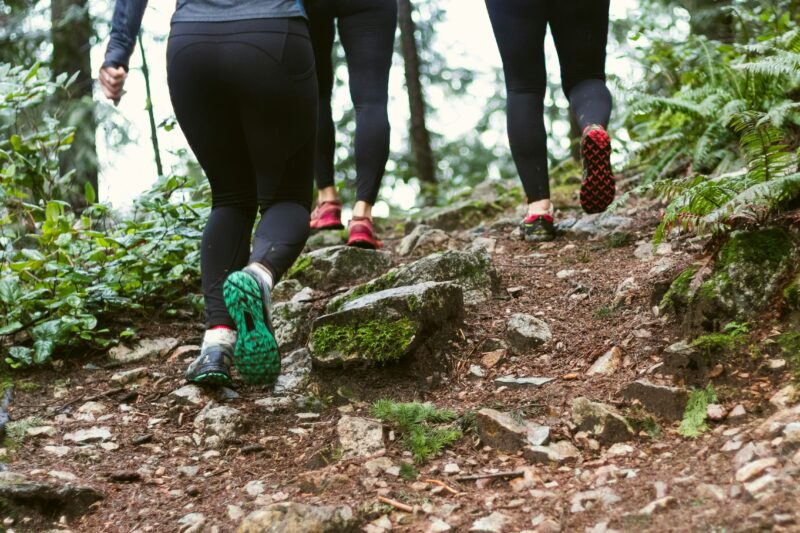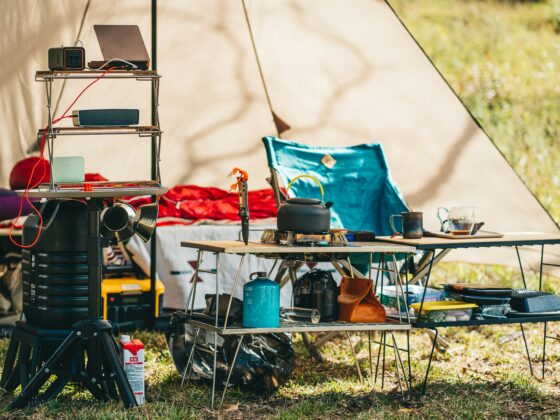Experience the thrill of trail running while immersing yourself in the beauty of nature with camping. Imagine waking up in the heart of the wilderness, surrounded by towering trees and the peaceful sounds of chirping birds. Trail running while camping allows you to unleash your inner adventurer and explore breathtaking trails that wind through mountains, forests, and valleys. Not only does trail running provide an invigorating workout, but it also offers a unique opportunity to connect with nature on a deeper level. As you navigate rugged terrains and conquer challenging inclines, you’ll experience a sense of accomplishment like no other.
Preparing adequately is essential to ensure a successful trail running and camping experience. From choosing the right camping gear to planning your running routes, this article will guide you through every step. Discover tips on finding the best trail running spots, fueling your body with nutritious meals, and staying safe during your adventures. So, lace up your running shoes, pack your tent, and get ready to embark on an unforgettable trail running journey while camping.
What is trail running?
Trail running is a popular outdoor activity involving trails, often in natural and scenic environments such as mountains, forests, or national parks. Unlike road running, which takes place on paved surfaces, trail running allows you to immerse yourself in nature while enjoying the physical and mental benefits of running. The uneven terrain, varying elevations, and unpredictable obstacles make trail running a challenging yet rewarding experience.
Trail running offers a refreshing change of pace from traditional road running, providing a more dynamic and engaging workout. The ever-changing scenery, fresh air, and solitude of the trails create a sense of freedom and connection with nature that is hard to replicate in a gym or on city streets. Whether you’re a seasoned trail runner or new to the sport, trail running while camping adds an extra layer of adventure and exploration to your running routine.
Benefits of trail running while camping
Trail running while camping offers a multitude of benefits for both your physical and mental well-being. Here are some of the key advantages of combining these two exhilarating activities:
- Stronger muscles and improved balance: Trail running engages a wider range of muscles compared to road running as you navigate uneven terrain and negotiate obstacles. This helps develop stronger leg muscles and improve your overall balance and coordination.
- Enhanced cardiovascular fitness: The varying elevations and challenging terrain of trail running provide an excellent cardiovascular workout. Running on trails requires more effort and energy compared to running on flat surfaces, resulting in improved endurance and cardiovascular fitness.
- Reduced impact on joints: Compared to running on hard pavement, trail running offers a softer surface that reduces the impact on your joints. The natural cushioning provided by the ground helps to protect your knees and ankles, making trail running a more joint-friendly option.
- Connection with nature: Trail running while camping allows you to fully immerse yourself in the beauty of nature. The tranquil surroundings, fresh air, and scenic views create a sense of peace and serenity that can help reduce stress and improve your overall well-being.
- Mental clarity and focus: The combination of physical exertion and natural surroundings can positively impact your mental health. Trail running provides an opportunity to disconnect from the stresses of daily life and focus solely on the present moment, promoting mental clarity and reducing anxiety.
Essential gear for trail running while camping
When venturing into trail running while camping, having the right gear is essential to ensure your safety and comfort. Here are some key pieces of gear that you should consider:
- Trail running shoes: Invest in a pair of trail running shoes that provide good traction, stability, and durability. Look for shoes with aggressive tread patterns to handle various terrains and weather conditions. Ensure that the shoes fit well and provide ample support for your feet.
- Hydration pack or water bottle: Staying hydrated during trail running is crucial, especially when camping in remote areas. Consider using a hydration pack that allows you to carry water on your back or a lightweight water bottle that is easy to access while running.
- Moisture-wicking clothing: Choose moisture-wicking clothing that helps keep you dry and comfortable during your runs. Avoid cotton materials, as they tend to retain moisture and can lead to discomfort and chafing. Opt for lightweight, breathable fabrics that provide ventilation and protection from the elements.
- Proper clothing layers: Dress in layers to regulate your body temperature depending on the weather and trail conditions. Start with a moisture-wicking base layer, add insulation if needed, and top it off with a windproof and waterproof outer layer. Don’t forget sun protection accessories like a hat, gloves, and sunglasses.
- Navigation tools: Carry a map, compass, or GPS device to help you navigate the trails and avoid getting lost. Familiarize yourself with the trail maps beforehand and have a backup plan in case of unexpected detours or changes in weather conditions.
- First aid kit: Always carry a basic kit that includes essentials such as adhesive bandages, antiseptic wipes, blister treatment, painkillers, and any necessary personal medications. Accidents and injuries can happen, so being prepared for any situation is important.
Remember, safety should always be your top priority when trail running while camping. Be prepared for the unexpected and adjust your gear accordingly based on the specific conditions of your trail running adventure. Consider visiting an outdoor store to find what gear and equipment you will need.
Safety tips for trail running while camping
Trail running while camping can be an exhilarating experience, but it’s essential to prioritize safety to ensure an enjoyable and incident-free trip. Here are some basic safety tips to keep in mind:
- Research and plan your routes: Before hitting the trails, search for ‘hiking trails near me‘ to find the area’s best options for trail running. Familiarize yourself with the routes you plan to run, including trail maps, elevation profiles, and any potential hazards or closures. It’s also good to inform someone about your route and estimated return time, especially if you’re running alone.
- Check weather conditions: Monitor the weather forecast closely before your camping and trail running adventure. Be prepared for changes in weather conditions and adjust your plans accordingly. Avoid running in severe weather conditions like thunderstorms, heavy rain, or extreme heat.
- Stay aware of your surroundings: While trail running, always pay attention to your surroundings. Be mindful of any potential hazards, such as loose rocks, tree roots, or wildlife. Stay on marked trails and avoid venturing off into unknown areas.
- Use proper running technique: Trail running requires a technique different from road running. Take shorter and quicker strides to maintain balance and stability on uneven terrain. Use your arms for balance and to help propel yourself forward. Be cautious on descents and use a controlled running style to avoid tripping or falling.
- Carry a whistle or signaling device: In case of an emergency or if you get lost, carry a whistle or signaling device that can help attract attention. Three blasts on a whistle is a recognized distress signal.
- Be mindful of wildlife: Respect the wildlife and their natural habitat while trail running. Keep a safe distance and avoid disturbing or feeding animals. Be aware of potential encounters with animals such as bears or snakes, and educate yourself on the appropriate actions.
By following these safety tips, you can minimize the risks associated with trail running while camping and focus on enjoying your adventure to the fullest.
Planning your trail running route
When planning your trail running routes while camping, several factors must be considered to ensure an enjoyable and rewarding experience. Here are some tips to help you plan your routes effectively:
- Research trail difficulty: Determine the difficulty level of the trails you wish to run. Consider your fitness level, trail running experience, and your trip’s overall goals. Choose trails that align with your abilities and gradually increase the difficulty as you gain more experience.
- Consider distance and elevation: The trails’ distance and elevation gain should be taken into account. If you’re new to trail running, start with shorter, less challenging routes to avoid overexertion. Gradually increase the distance and elevation as your fitness level improves.
- Explore different terrains: Variety is the spice of life, and the same goes for trail running. Explore trails that offer different terrains, such as rocky paths, forest trails, or mountainous routes. This will not only keep your runs exciting but also challenge your body in various ways.
- Check for water sources: Depending on the length of your run, it’s important to know if there are any water sources along the trail. Carry enough water or plan your route to pass by streams or lakes where you can refill your water supply. Staying hydrated is crucial, especially during longer runs.
- Time your runs: When planning your trail running routes, consider the time of day. Running early in the morning or late in the evening can offer cooler temperatures and quieter trails. Avoid running during peak hours, when the trails might be crowded.
- Combine loops and out-and-back routes: Mix up your trail-running routes by combining loops and out-and-back routes. This allows you to cover more ground and experience different sections of the trail without repeating the same scenery.
Also, when planning your camping trip, consider looking for ‘camp sites near Manila‘ to find suitable locations for your adventure. Research campgrounds or outdoor areas within a reasonable distance from Manila that offer amenities such as designated campsites, access to trails, and facilities like bathrooms and water sources. Choose a campsite that aligns with your preferences and the activities you have planned for your trail running adventure.
By carefully planning your trail running routes, you can maximize your enjoyment, challenge yourself appropriately, and discover the beauty of the trails while camping.
Nutrition and hydration for trail running while camping
Proper nutrition and hydration are key to fueling your body for trail running while camping. Here are some tips to help you stay energized and nourished during your runs:
- Pre-run fueling: Eat a balanced meal containing carbohydrates, protein, and healthy fats before your run. Choose easily digestible foods such as oatmeal, bananas, yogurt, or toast with nut butter. Give yourself enough time to digest before hitting the trails.
- Carry energy-packed snacks: Pack lightweight and energy-dense snacks to fuel your runs. Trail mix, energy bars, gels, dried fruits, and nuts are all great options. Aim to consume small portions of these snacks every 30-45 minutes to maintain energy levels.
- Stay hydrated: Hydration is crucial for trail running, especially in warm or humid conditions. Drink water regularly before, during, and after your runs to stay properly hydrated. Consider using electrolyte supplements or sports drinks to replenish lost minerals and salts.
- Plan for post-run recovery: After your runs refuel your body with a combination of carbohydrates and protein to aid in muscle repair and recovery. Pack a nutritious post-run meal or snack such as a smoothie, protein bar, or a balanced meal with lean protein and vegetables.
- Pack portable cooking equipment: If you’re camping for multiple days, consider packing portable cooking equipment such as a stove or grill. This allows you to prepare hot meals and enjoy a wider variety of nutritious foods, such as soups, stews, grilled vegetables, and lean meats.
- Consider dietary restrictions: Plan your meals and snacks accordingly if you have any dietary restrictions or food allergies. Research camping-friendly recipes that cater to your specific needs and ensure you have all the necessary ingredients.
Remember to listen to your body and adjust your nutrition and hydration strategies based on your needs and preferences. Experiment with different foods and hydration methods during training to find what works best for you.
Trail running etiquette and environmental considerations
When trail running while camping, it’s important to be mindful of trail etiquette and practice responsible environmental stewardship. Here are some guidelines to follow:
- Yield to others: When encountering hikers, bikers, or other trail users, yield the right of way to them. Slow down or step aside to allow them to pass safely. Be courteous and respectful to fellow trail users, and always maintain a positive attitude.
- Respect trail closures: Respect any trail closures or restrictions due to weather conditions, wildlife preservation, or maintenance activities. These closures protect the trails and the environment.
- Leave no trace: Practice leave no trace principles to minimize your impact on the environment. Pack out all your trash, including food wrappers and tissues. Avoid littering and dispose of waste properly in designated bins.
- Stay on marked trails: Stick to marked trails and avoid creating new paths or shortcuts. This helps preserve the natural vegetation and prevents erosion. Deviating from established trails can also disturb wildlife habitats.
- Avoid loud noises: Keep noise levels to a minimum to avoid disturbing wildlife and fellow trail users. Enjoy the quiet serenity of nature, and be mindful of the impact of your presence on the environment.
- Educate yourself: Learn about the local flora and fauna, as well as any specific environmental concerns in the area you’re visiting. Familiarize yourself with the rules and regulations of the park or trail system to ensure you’re acting responsibly.
By practicing trail running etiquette and being environmentally conscious, you can help preserve the beauty of the trails for future generations of runners and campers.
Training tips for trail running while camping
Trail running while camping requires specific training to prepare your body for the challenges of uneven terrain and varying elevations. Here are some training tips to help you get ready for your trail running adventure:
- Gradual progression: If you’re new to trail running or haven’t run on challenging terrains, start with shorter distances and gradually increase your mileage. Allow your body time to adapt to the demands of trail running to prevent injuries.
- Incorporate hill workouts: Include hill workouts in your training routine to build strength and endurance. Find hills or inclines in your local area and practice running uphill at a steady pace. Focus on maintaining good form and using your arms to propel yourself forward.
- Strength training: Incorporate strength training exercises into your routine to build muscle strength and stability. Target muscles commonly used in trail running, such as the glutes, quadriceps, calves, and core. Exercises like squats, lunges, step-ups, and planks can help improve your overall running performance.
- Balance and stability exercises: Trail running requires good balance and stability to navigate uneven terrain. Include exercises that improve balance, such as single-leg squats, lateral lunges, and stability ball exercises. Incorporate balance training into your warm-up routine to activate your stabilizing muscles.
- Practice trail-specific skills: Incorporate trail-specific skills into your training. Find local trails or parks with similar terrain to your camping destination, practice running on uneven surfaces, navigating obstacles, and adjusting your stride and pace to match the trail’s conditions. This will help you familiarize yourself with the challenges you may encounter during your camping trail run. By incorporating these training tips into your routine, you’ll be better prepared to enjoy the thrill of trail running while camping and make the most of your outdoor adventure.



